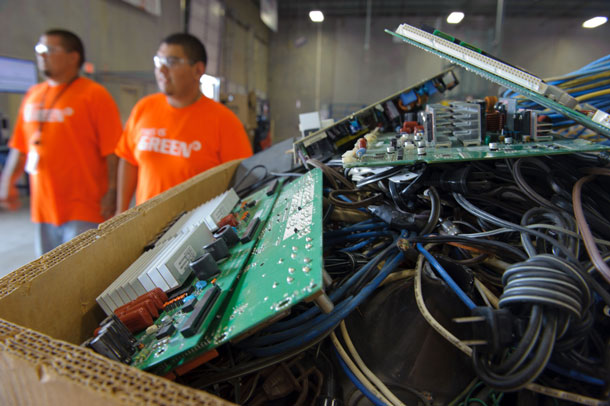The Right To Repair
Air Date: Week of December 7, 2018

Electronics are a rapidly growing part of the waste stream, because devices like smartphones are becoming more difficult and expensive to repair. (Photo: U.S. Environmental Protection Agency, Wikimedia commons, public domain)
The Right to Repair movement promotes resources people need to fix their stuff, from smartphones to dishwashers to agricultural equipment. The movement started as a response to the growing stream of e-waste but has expanded past that. Nathan Proctor is the Director of US PIRG’s Right to Repair campaign and he spoke with Host Steve Curwood.
Transcript
CURWOOD: As we have more stuff, we produce more and more waste. One response to our throw away culture is the Right to Repair, a movement to get people the things they need to fix their stuff. In October, the Library of Congress and the US Copyright Office modified rules to allow consumers to hack into embedded software as needed for repair and maintenance. A major win for the Right the Repair movement, but as Nathan Proctor explains, there’s still a ways to go. Nathan is with the Right to Repair campaign of the Public Interest Research Group. And he joins us now. Welcome to Living on Earth.
PROCTOR: Thank you, Steve. It's great to be here.
CURWOOD: So, tell us about the Right to Repair movement. What exactly is it? And how does it relate to environmental impact?
PROCTOR: Well, I believe that people should be able to fix their stuff. And when you can't fix something, it means that it ends up in the waste stream before it might normally need to go in the trash. And as our world has gotten more and more computerized, it's getting more and more difficult for people to maintain the things in their lives. And this is true of our smartphones and our dishwashers and even of tractors and other ag. equipment.
CURWOOD: Well, we all know what it's like to call a service person and imagine you have a big piece of equipment out in the middle of the field and you're trying to move forward with this planting or this harvest. I imagine the bill just to have somebody come and have them come on a timely basis is going to be fairly steep, as opposed to just simply putting one's own head under the hood and figuring out what's going wrong here.
PROCTOR: Yeah. Most farmers who had their own farm equipment usually had ways to keep that equipment going that was more or less local to them. If they couldn't fix it, there was somebody close by who could fix it. And as these products started getting more and more computerized, there were examples where they took those tools into their own hands in order to execute repairs. And the most famous example now is a set of farmers in Nebraska, who when they were faced with an impossible repair, instead of loading their combine onto a flatbed truck and driving it to the dealership, which would have cost them several thousand dollars, and potentially could have affected their ability to harvest the crops that they were using. The story goes that they hired Ukrainian hackers using Bit Torrent to send broken cracked versions of the John Deere software, so that they could access the same tools that the dealership would use to diagnose and repair a tractor.
CURWOOD: So a few hundred bucks to a hacker instead of a few thousand bucks to the dealer, huh?

The California Farm Bureau Federation reached an agreement with the Far West Equipment Dealer’s Association to increase farmers’ access to parts and software needed for repair. Many criticize the agreement as not going far enough to ensure farmers’ rights to fix their property. (Photo: werktuigendagen, Wikimedia commons, CC BY-SA 2.0)
PROCTOR: Yeah, and in 2015, the Library of Congress issued an exemption to the Digital Millennium Copyright Act for ag equipment, specifically saying that farmers had the right to modify software if it interfered with their ability to repair their device. And almost overnight, John Deere updated their terms of service for using a tractor. You know, when you, like, download a new app, you get that 12-page agreement that you unthinkingly hit “agree” on. They updated those terms of service to basically make any modification to the software to be a violation of those terms of service.
CURWOOD: So, just how common is it that consumers can't repair their own stuff? What does that usually look like?
PROCTOR: Well, we know that electronic waste is one of the most rapidly growing parts of the waste stream. And the UN estimates that 60 million tons of electronic waste is generated each year...60 million tons of e-waste would be about 125,000 jumbo jets worth.
CURWOOD: Oh, my.
PROCTOR: And Americans throw out 416,000 smartphones every day.
CURWOOD: Whoa.
PROCTOR: So, we buy these incredible $800 computers, which are very useful. I like to say that on Star Trek, they had five different devices to do the things that one smartphone can do. And we treat them as they're essentially disposable. And this is kind of a new thing that's happening in the world of consumer goods. I mean, 10 years ago, it would be un-thought of to buy a phone and keep it for one year, and then upgrade to another phone.

Nathan Proctor is the Director of US PIRG’s Right to Repair campaign. (Photo: Courtesy of Nathan Proctor)
CURWOOD: OK, so what is it about our smartphones, that we're just chucking them instead of fixing them?
PROCTOR: One of the main problems with our smartphones is that the batteries are very difficult to replace. They are held in with adhesive and the instructions for how to properly switch them out are not being provided by the manufacturers anymore. And the original replacement batteries are no longer being sold by the manufacturer. You have to go through an authorized provider to get that battery service. And a lot of times, if you take it to that provider, they will just try to sell you a new phone.
CURWOOD: In your view, what's the model legislation for a Right to Repair bill?
PROCTOR: So, our model Right to Repair bill includes five things that we think are necessary for repair. We think of them like a five legged stool, which means that if it missing one leg, it's still stable, but it's much more stable with all five legs. And those five things are access to replacement parts, any specialized tools needed for repair, diagnostic software, manuals or schematics, and firmware. And if you have all five of those things, then you can fix it.
CURWOOD: Nathan Proctor is Director of the US Public Interest Research Group’s Right to Repair campaign. Thanks for taking the time today, Nathan.
PROCTOR: Thank you.
Links
US PIRG’s Right to Repair campaign homepage
Original announcement from the California Farm Bureau Federation on the “right to repair” agreement
Living on Earth wants to hear from you!
Living on Earth
62 Calef Highway, Suite 212
Lee, NH 03861
Telephone: 617-287-4121
E-mail: comments@loe.org
Newsletter [Click here]
Donate to Living on Earth!
Living on Earth is an independent media program and relies entirely on contributions from listeners and institutions supporting public service. Please donate now to preserve an independent environmental voice.
NewsletterLiving on Earth offers a weekly delivery of the show's rundown to your mailbox. Sign up for our newsletter today!
 Sailors For The Sea: Be the change you want to sea.
Sailors For The Sea: Be the change you want to sea.
 The Grantham Foundation for the Protection of the Environment: Committed to protecting and improving the health of the global environment.
The Grantham Foundation for the Protection of the Environment: Committed to protecting and improving the health of the global environment.
 Contribute to Living on Earth and receive, as our gift to you, an archival print of one of Mark Seth Lender's extraordinary wildlife photographs. Follow the link to see Mark's current collection of photographs.
Contribute to Living on Earth and receive, as our gift to you, an archival print of one of Mark Seth Lender's extraordinary wildlife photographs. Follow the link to see Mark's current collection of photographs.
 Buy a signed copy of Mark Seth Lender's book Smeagull the Seagull & support Living on Earth
Buy a signed copy of Mark Seth Lender's book Smeagull the Seagull & support Living on Earth

